HI5002 Finance for Business: Detailed Financial Analysis of Woolworths
VerifiedAdded on 2023/01/11
|13
|4438
|94
Report
AI Summary
This report provides a comprehensive financial analysis of Woolworths Ltd, focusing on its financial performance and cash management strategies. The report begins with an abstract highlighting the importance of efficient cash management for business success, followed by an introduction to the company, a leading Australian supermarket chain. The core of the report involves a detailed financial analysis using profitability, liquidity, and efficiency ratios, including gross profit margin, net profit margin, current ratio, quick ratio, inventory turnover, and asset turnover. The analysis covers financial data from 2017 to 2019, providing insights into Woolworths' financial health and operational efficiency. Furthermore, the report examines cash management practices, emphasizing the significance of marketable securities like common stock and commercial papers for maintaining a healthy cash flow. The report concludes that optimal finance allocation ensures proper management and effective operations. The assignment is prepared for the HI5002 Finance for Business course.
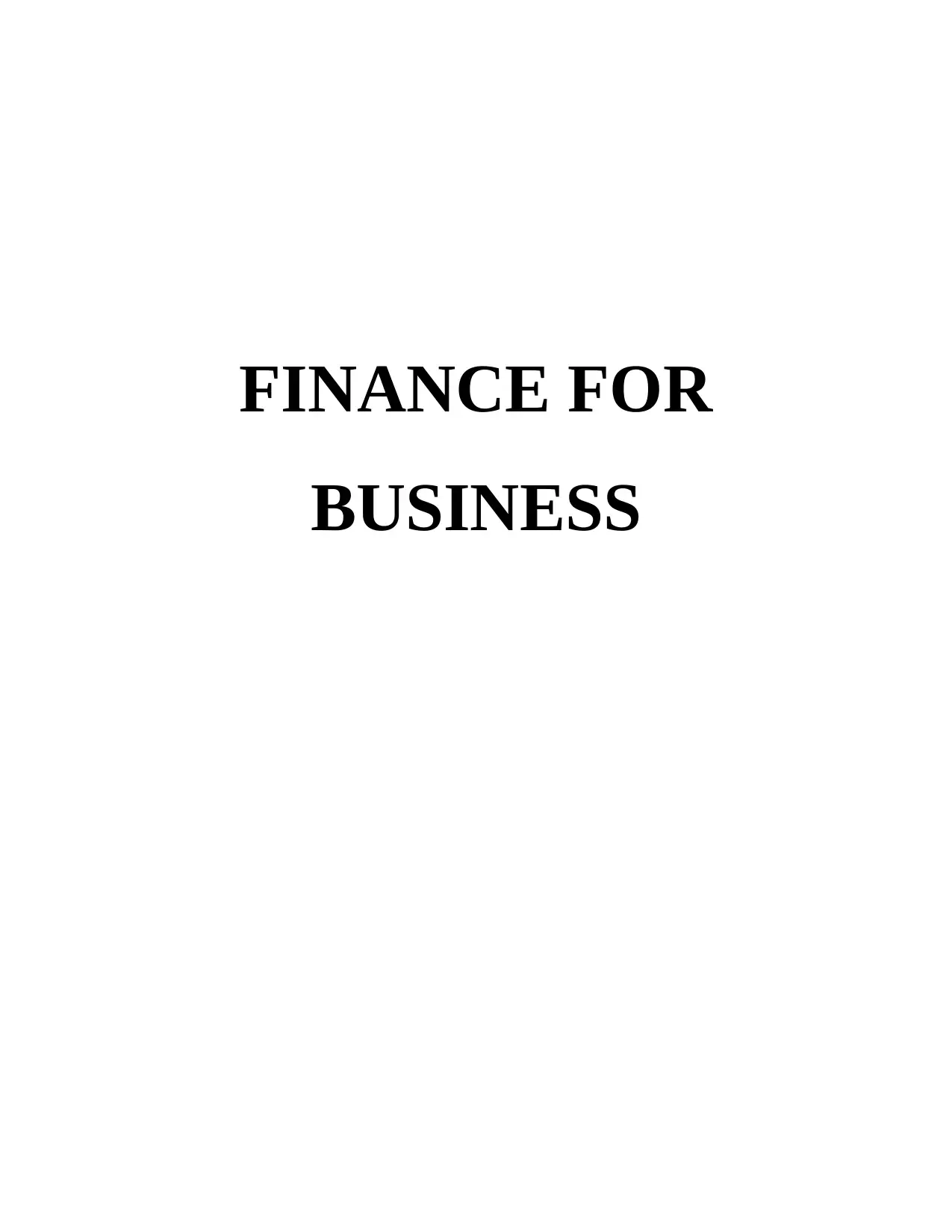
FINANCE FOR
BUSINESS
BUSINESS
Paraphrase This Document
Need a fresh take? Get an instant paraphrase of this document with our AI Paraphraser
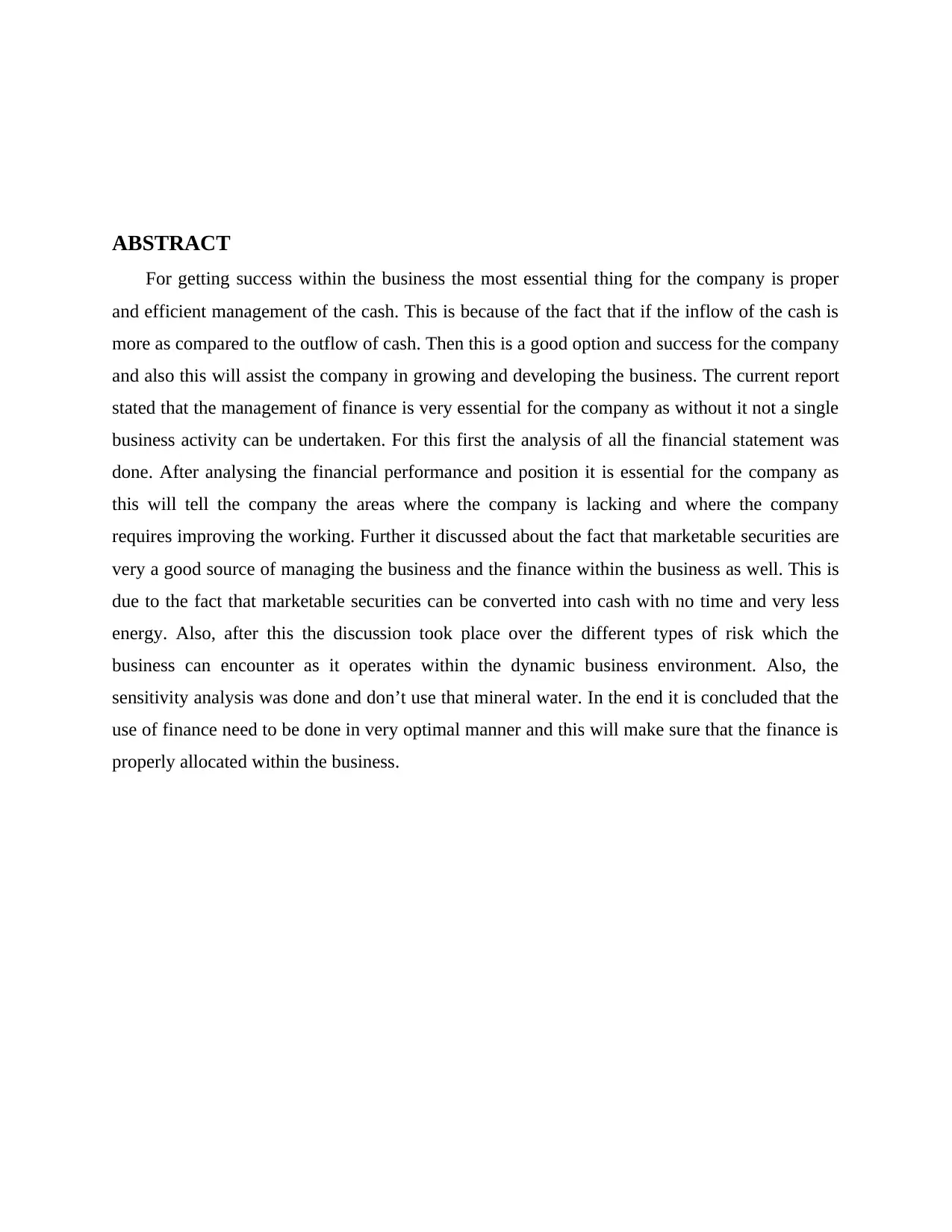
ABSTRACT
For getting success within the business the most essential thing for the company is proper
and efficient management of the cash. This is because of the fact that if the inflow of the cash is
more as compared to the outflow of cash. Then this is a good option and success for the company
and also this will assist the company in growing and developing the business. The current report
stated that the management of finance is very essential for the company as without it not a single
business activity can be undertaken. For this first the analysis of all the financial statement was
done. After analysing the financial performance and position it is essential for the company as
this will tell the company the areas where the company is lacking and where the company
requires improving the working. Further it discussed about the fact that marketable securities are
very a good source of managing the business and the finance within the business as well. This is
due to the fact that marketable securities can be converted into cash with no time and very less
energy. Also, after this the discussion took place over the different types of risk which the
business can encounter as it operates within the dynamic business environment. Also, the
sensitivity analysis was done and don’t use that mineral water. In the end it is concluded that the
use of finance need to be done in very optimal manner and this will make sure that the finance is
properly allocated within the business.
For getting success within the business the most essential thing for the company is proper
and efficient management of the cash. This is because of the fact that if the inflow of the cash is
more as compared to the outflow of cash. Then this is a good option and success for the company
and also this will assist the company in growing and developing the business. The current report
stated that the management of finance is very essential for the company as without it not a single
business activity can be undertaken. For this first the analysis of all the financial statement was
done. After analysing the financial performance and position it is essential for the company as
this will tell the company the areas where the company is lacking and where the company
requires improving the working. Further it discussed about the fact that marketable securities are
very a good source of managing the business and the finance within the business as well. This is
due to the fact that marketable securities can be converted into cash with no time and very less
energy. Also, after this the discussion took place over the different types of risk which the
business can encounter as it operates within the dynamic business environment. Also, the
sensitivity analysis was done and don’t use that mineral water. In the end it is concluded that the
use of finance need to be done in very optimal manner and this will make sure that the finance is
properly allocated within the business.
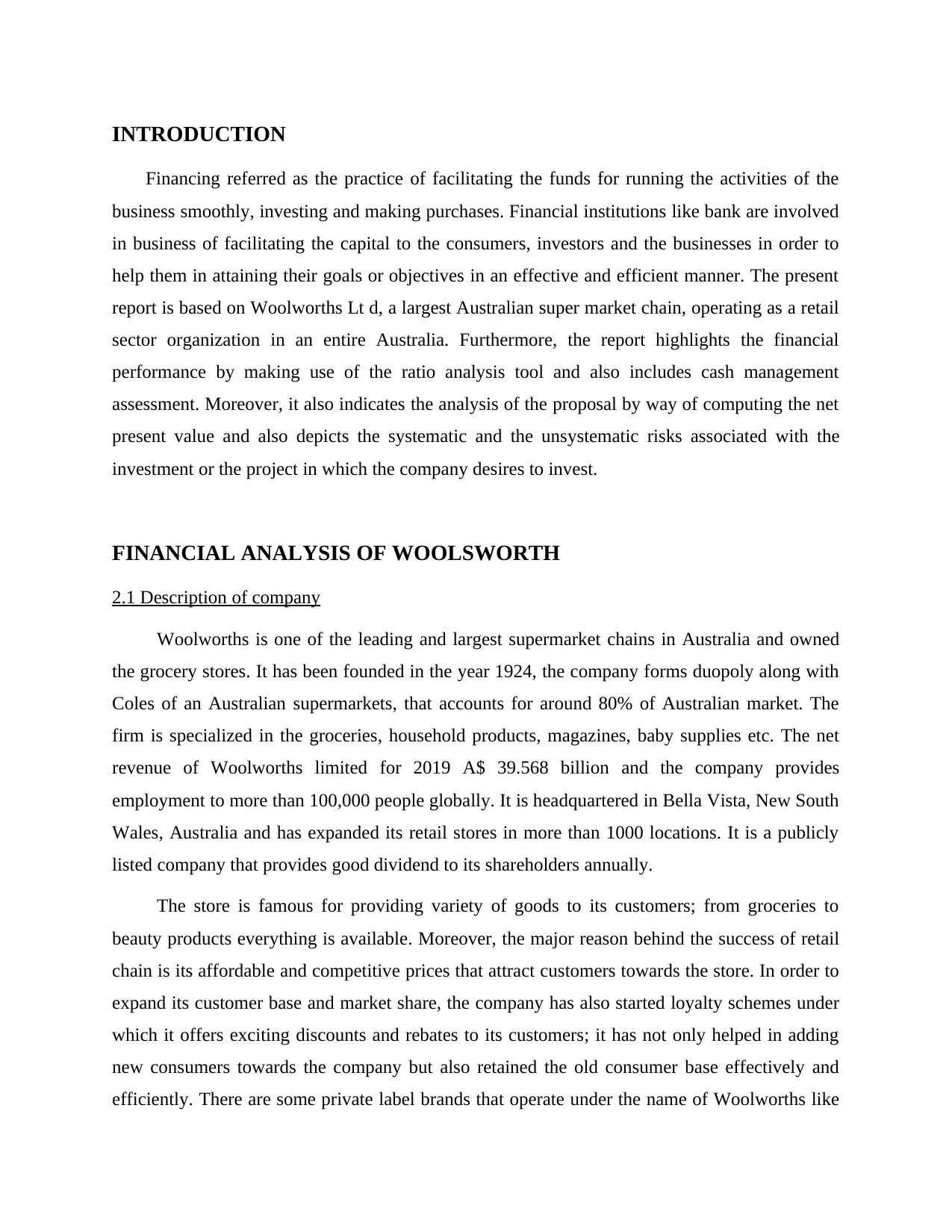
INTRODUCTION
Financing referred as the practice of facilitating the funds for running the activities of the
business smoothly, investing and making purchases. Financial institutions like bank are involved
in business of facilitating the capital to the consumers, investors and the businesses in order to
help them in attaining their goals or objectives in an effective and efficient manner. The present
report is based on Woolworths Lt d, a largest Australian super market chain, operating as a retail
sector organization in an entire Australia. Furthermore, the report highlights the financial
performance by making use of the ratio analysis tool and also includes cash management
assessment. Moreover, it also indicates the analysis of the proposal by way of computing the net
present value and also depicts the systematic and the unsystematic risks associated with the
investment or the project in which the company desires to invest.
FINANCIAL ANALYSIS OF WOOLSWORTH
2.1 Description of company
Woolworths is one of the leading and largest supermarket chains in Australia and owned
the grocery stores. It has been founded in the year 1924, the company forms duopoly along with
Coles of an Australian supermarkets, that accounts for around 80% of Australian market. The
firm is specialized in the groceries, household products, magazines, baby supplies etc. The net
revenue of Woolworths limited for 2019 A$ 39.568 billion and the company provides
employment to more than 100,000 people globally. It is headquartered in Bella Vista, New South
Wales, Australia and has expanded its retail stores in more than 1000 locations. It is a publicly
listed company that provides good dividend to its shareholders annually.
The store is famous for providing variety of goods to its customers; from groceries to
beauty products everything is available. Moreover, the major reason behind the success of retail
chain is its affordable and competitive prices that attract customers towards the store. In order to
expand its customer base and market share, the company has also started loyalty schemes under
which it offers exciting discounts and rebates to its customers; it has not only helped in adding
new consumers towards the company but also retained the old consumer base effectively and
efficiently. There are some private label brands that operate under the name of Woolworths like
Financing referred as the practice of facilitating the funds for running the activities of the
business smoothly, investing and making purchases. Financial institutions like bank are involved
in business of facilitating the capital to the consumers, investors and the businesses in order to
help them in attaining their goals or objectives in an effective and efficient manner. The present
report is based on Woolworths Lt d, a largest Australian super market chain, operating as a retail
sector organization in an entire Australia. Furthermore, the report highlights the financial
performance by making use of the ratio analysis tool and also includes cash management
assessment. Moreover, it also indicates the analysis of the proposal by way of computing the net
present value and also depicts the systematic and the unsystematic risks associated with the
investment or the project in which the company desires to invest.
FINANCIAL ANALYSIS OF WOOLSWORTH
2.1 Description of company
Woolworths is one of the leading and largest supermarket chains in Australia and owned
the grocery stores. It has been founded in the year 1924, the company forms duopoly along with
Coles of an Australian supermarkets, that accounts for around 80% of Australian market. The
firm is specialized in the groceries, household products, magazines, baby supplies etc. The net
revenue of Woolworths limited for 2019 A$ 39.568 billion and the company provides
employment to more than 100,000 people globally. It is headquartered in Bella Vista, New South
Wales, Australia and has expanded its retail stores in more than 1000 locations. It is a publicly
listed company that provides good dividend to its shareholders annually.
The store is famous for providing variety of goods to its customers; from groceries to
beauty products everything is available. Moreover, the major reason behind the success of retail
chain is its affordable and competitive prices that attract customers towards the store. In order to
expand its customer base and market share, the company has also started loyalty schemes under
which it offers exciting discounts and rebates to its customers; it has not only helped in adding
new consumers towards the company but also retained the old consumer base effectively and
efficiently. There are some private label brands that operate under the name of Woolworths like
⊘ This is a preview!⊘
Do you want full access?
Subscribe today to unlock all pages.

Trusted by 1+ million students worldwide
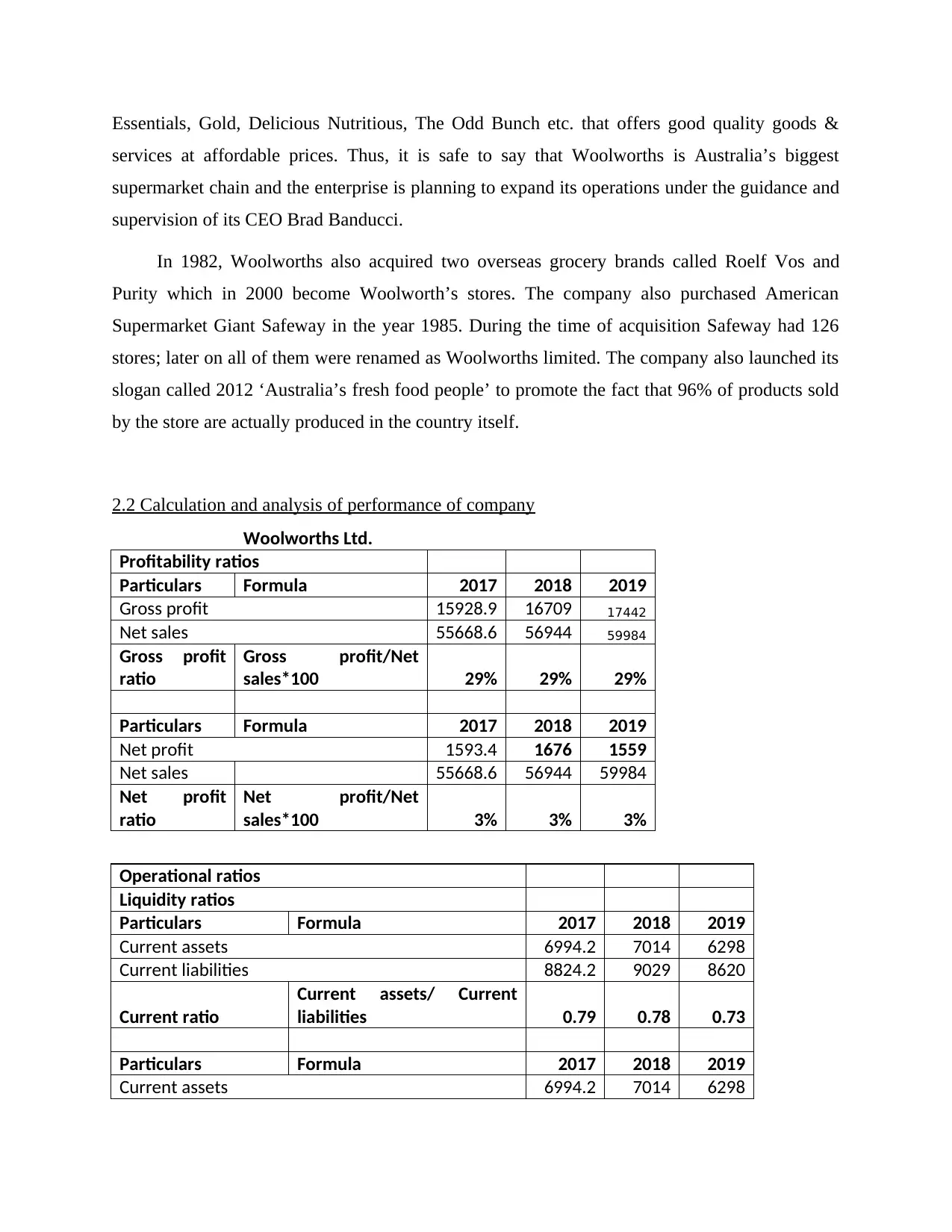
Essentials, Gold, Delicious Nutritious, The Odd Bunch etc. that offers good quality goods &
services at affordable prices. Thus, it is safe to say that Woolworths is Australia’s biggest
supermarket chain and the enterprise is planning to expand its operations under the guidance and
supervision of its CEO Brad Banducci.
In 1982, Woolworths also acquired two overseas grocery brands called Roelf Vos and
Purity which in 2000 become Woolworth’s stores. The company also purchased American
Supermarket Giant Safeway in the year 1985. During the time of acquisition Safeway had 126
stores; later on all of them were renamed as Woolworths limited. The company also launched its
slogan called 2012 ‘Australia’s fresh food people’ to promote the fact that 96% of products sold
by the store are actually produced in the country itself.
2.2 Calculation and analysis of performance of company
Woolworths Ltd.
Profitability ratios
Particulars Formula 2017 2018 2019
Gross profit 15928.9 16709 17442
Net sales 55668.6 56944 59984
Gross profit
ratio
Gross profit/Net
sales*100 29% 29% 29%
Particulars Formula 2017 2018 2019
Net profit 1593.4 1676 1559
Net sales 55668.6 56944 59984
Net profit
ratio
Net profit/Net
sales*100 3% 3% 3%
Operational ratios
Liquidity ratios
Particulars Formula 2017 2018 2019
Current assets 6994.2 7014 6298
Current liabilities 8824.2 9029 8620
Current ratio
Current assets/ Current
liabilities 0.79 0.78 0.73
Particulars Formula 2017 2018 2019
Current assets 6994.2 7014 6298
services at affordable prices. Thus, it is safe to say that Woolworths is Australia’s biggest
supermarket chain and the enterprise is planning to expand its operations under the guidance and
supervision of its CEO Brad Banducci.
In 1982, Woolworths also acquired two overseas grocery brands called Roelf Vos and
Purity which in 2000 become Woolworth’s stores. The company also purchased American
Supermarket Giant Safeway in the year 1985. During the time of acquisition Safeway had 126
stores; later on all of them were renamed as Woolworths limited. The company also launched its
slogan called 2012 ‘Australia’s fresh food people’ to promote the fact that 96% of products sold
by the store are actually produced in the country itself.
2.2 Calculation and analysis of performance of company
Woolworths Ltd.
Profitability ratios
Particulars Formula 2017 2018 2019
Gross profit 15928.9 16709 17442
Net sales 55668.6 56944 59984
Gross profit
ratio
Gross profit/Net
sales*100 29% 29% 29%
Particulars Formula 2017 2018 2019
Net profit 1593.4 1676 1559
Net sales 55668.6 56944 59984
Net profit
ratio
Net profit/Net
sales*100 3% 3% 3%
Operational ratios
Liquidity ratios
Particulars Formula 2017 2018 2019
Current assets 6994.2 7014 6298
Current liabilities 8824.2 9029 8620
Current ratio
Current assets/ Current
liabilities 0.79 0.78 0.73
Particulars Formula 2017 2018 2019
Current assets 6994.2 7014 6298
Paraphrase This Document
Need a fresh take? Get an instant paraphrase of this document with our AI Paraphraser
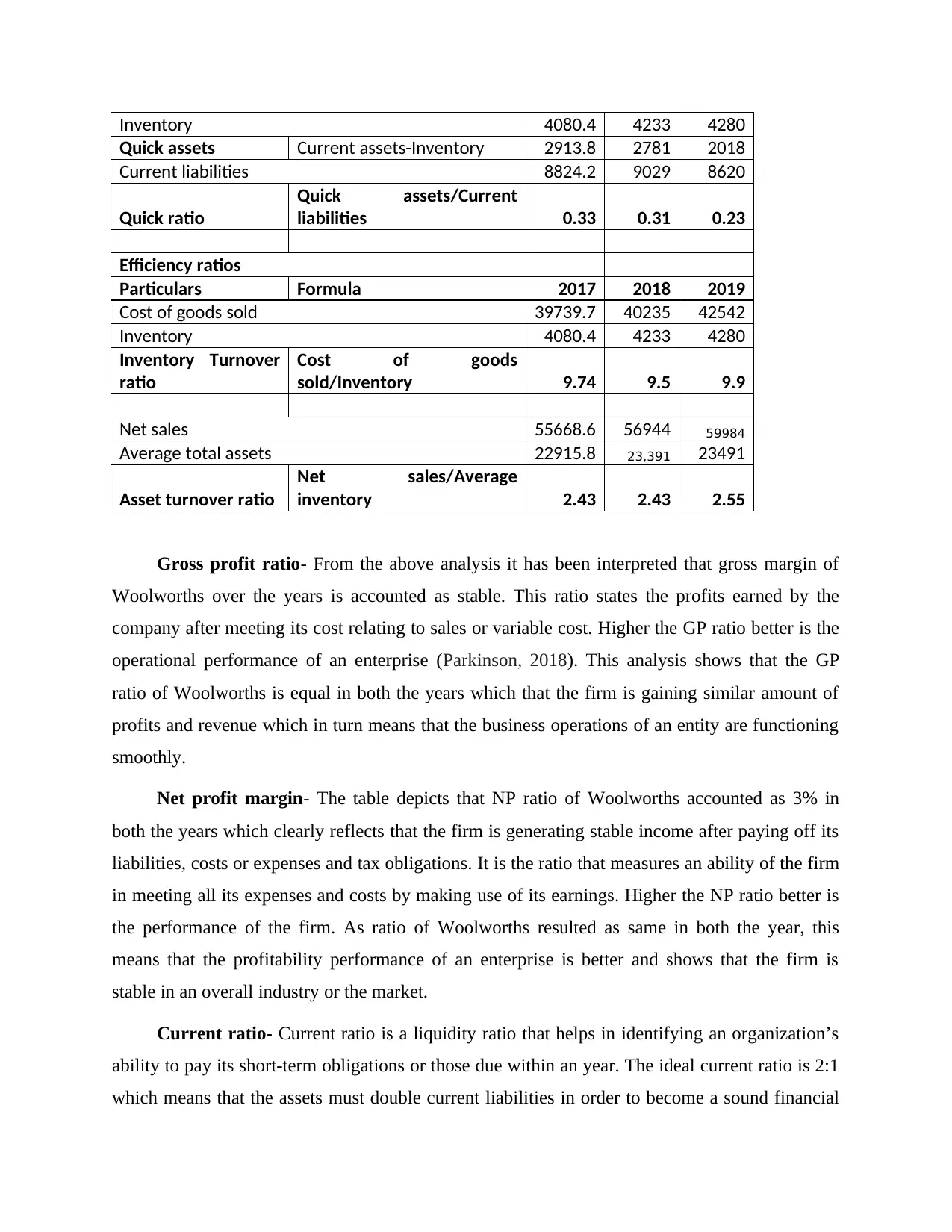
Inventory 4080.4 4233 4280
Quick assets Current assets-Inventory 2913.8 2781 2018
Current liabilities 8824.2 9029 8620
Quick ratio
Quick assets/Current
liabilities 0.33 0.31 0.23
Efficiency ratios
Particulars Formula 2017 2018 2019
Cost of goods sold 39739.7 40235 42542
Inventory 4080.4 4233 4280
Inventory Turnover
ratio
Cost of goods
sold/Inventory 9.74 9.5 9.9
Net sales 55668.6 56944 59984
Average total assets 22915.8 23,391 23491
Asset turnover ratio
Net sales/Average
inventory 2.43 2.43 2.55
Gross profit ratio- From the above analysis it has been interpreted that gross margin of
Woolworths over the years is accounted as stable. This ratio states the profits earned by the
company after meeting its cost relating to sales or variable cost. Higher the GP ratio better is the
operational performance of an enterprise (Parkinson, 2018). This analysis shows that the GP
ratio of Woolworths is equal in both the years which that the firm is gaining similar amount of
profits and revenue which in turn means that the business operations of an entity are functioning
smoothly.
Net profit margin- The table depicts that NP ratio of Woolworths accounted as 3% in
both the years which clearly reflects that the firm is generating stable income after paying off its
liabilities, costs or expenses and tax obligations. It is the ratio that measures an ability of the firm
in meeting all its expenses and costs by making use of its earnings. Higher the NP ratio better is
the performance of the firm. As ratio of Woolworths resulted as same in both the year, this
means that the profitability performance of an enterprise is better and shows that the firm is
stable in an overall industry or the market.
Current ratio- Current ratio is a liquidity ratio that helps in identifying an organization’s
ability to pay its short-term obligations or those due within an year. The ideal current ratio is 2:1
which means that the assets must double current liabilities in order to become a sound financial
Quick assets Current assets-Inventory 2913.8 2781 2018
Current liabilities 8824.2 9029 8620
Quick ratio
Quick assets/Current
liabilities 0.33 0.31 0.23
Efficiency ratios
Particulars Formula 2017 2018 2019
Cost of goods sold 39739.7 40235 42542
Inventory 4080.4 4233 4280
Inventory Turnover
ratio
Cost of goods
sold/Inventory 9.74 9.5 9.9
Net sales 55668.6 56944 59984
Average total assets 22915.8 23,391 23491
Asset turnover ratio
Net sales/Average
inventory 2.43 2.43 2.55
Gross profit ratio- From the above analysis it has been interpreted that gross margin of
Woolworths over the years is accounted as stable. This ratio states the profits earned by the
company after meeting its cost relating to sales or variable cost. Higher the GP ratio better is the
operational performance of an enterprise (Parkinson, 2018). This analysis shows that the GP
ratio of Woolworths is equal in both the years which that the firm is gaining similar amount of
profits and revenue which in turn means that the business operations of an entity are functioning
smoothly.
Net profit margin- The table depicts that NP ratio of Woolworths accounted as 3% in
both the years which clearly reflects that the firm is generating stable income after paying off its
liabilities, costs or expenses and tax obligations. It is the ratio that measures an ability of the firm
in meeting all its expenses and costs by making use of its earnings. Higher the NP ratio better is
the performance of the firm. As ratio of Woolworths resulted as same in both the year, this
means that the profitability performance of an enterprise is better and shows that the firm is
stable in an overall industry or the market.
Current ratio- Current ratio is a liquidity ratio that helps in identifying an organization’s
ability to pay its short-term obligations or those due within an year. The ideal current ratio is 2:1
which means that the assets must double current liabilities in order to become a sound financial
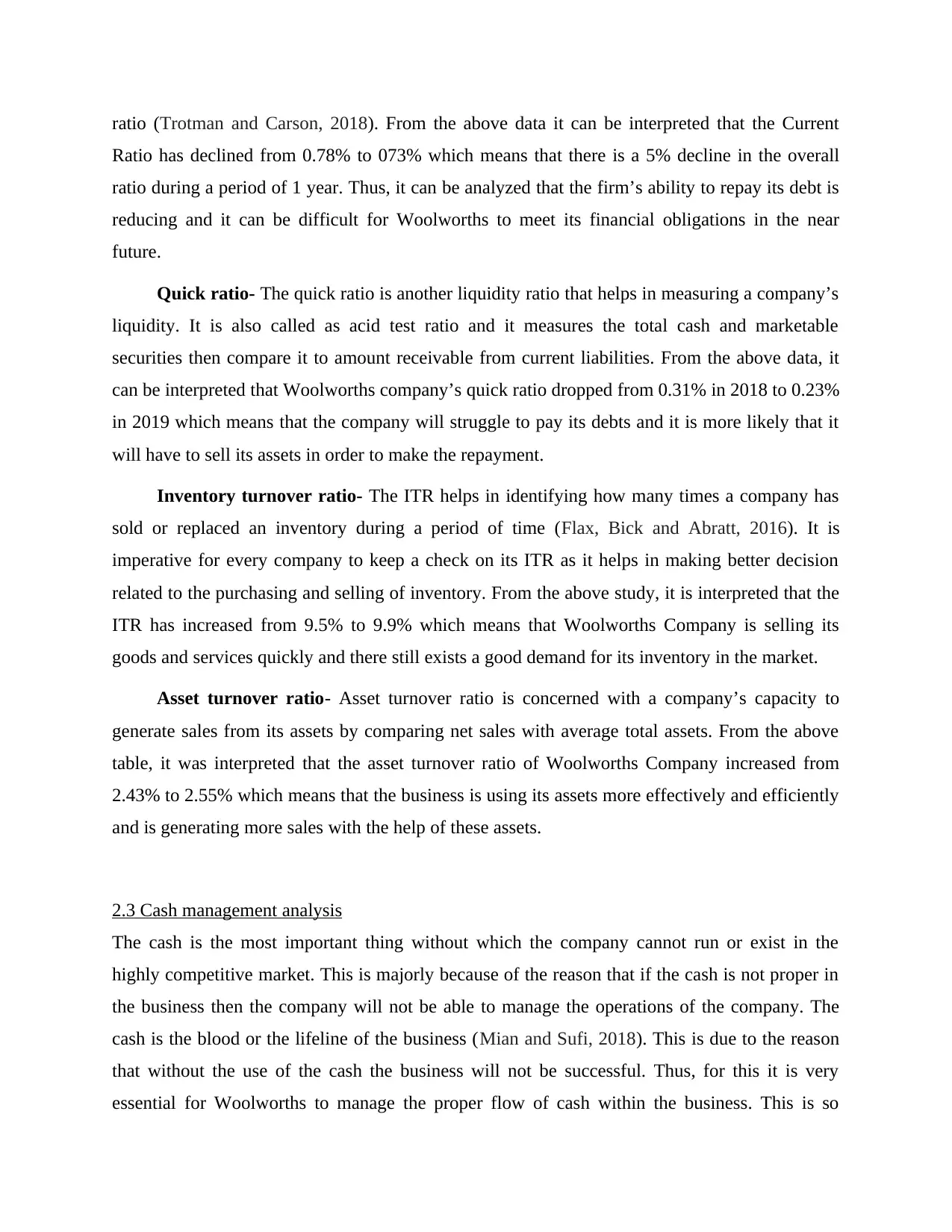
ratio (Trotman and Carson, 2018). From the above data it can be interpreted that the Current
Ratio has declined from 0.78% to 073% which means that there is a 5% decline in the overall
ratio during a period of 1 year. Thus, it can be analyzed that the firm’s ability to repay its debt is
reducing and it can be difficult for Woolworths to meet its financial obligations in the near
future.
Quick ratio- The quick ratio is another liquidity ratio that helps in measuring a company’s
liquidity. It is also called as acid test ratio and it measures the total cash and marketable
securities then compare it to amount receivable from current liabilities. From the above data, it
can be interpreted that Woolworths company’s quick ratio dropped from 0.31% in 2018 to 0.23%
in 2019 which means that the company will struggle to pay its debts and it is more likely that it
will have to sell its assets in order to make the repayment.
Inventory turnover ratio- The ITR helps in identifying how many times a company has
sold or replaced an inventory during a period of time (Flax, Bick and Abratt, 2016). It is
imperative for every company to keep a check on its ITR as it helps in making better decision
related to the purchasing and selling of inventory. From the above study, it is interpreted that the
ITR has increased from 9.5% to 9.9% which means that Woolworths Company is selling its
goods and services quickly and there still exists a good demand for its inventory in the market.
Asset turnover ratio- Asset turnover ratio is concerned with a company’s capacity to
generate sales from its assets by comparing net sales with average total assets. From the above
table, it was interpreted that the asset turnover ratio of Woolworths Company increased from
2.43% to 2.55% which means that the business is using its assets more effectively and efficiently
and is generating more sales with the help of these assets.
2.3 Cash management analysis
The cash is the most important thing without which the company cannot run or exist in the
highly competitive market. This is majorly because of the reason that if the cash is not proper in
the business then the company will not be able to manage the operations of the company. The
cash is the blood or the lifeline of the business (Mian and Sufi, 2018). This is due to the reason
that without the use of the cash the business will not be successful. Thus, for this it is very
essential for Woolworths to manage the proper flow of cash within the business. This is so
Ratio has declined from 0.78% to 073% which means that there is a 5% decline in the overall
ratio during a period of 1 year. Thus, it can be analyzed that the firm’s ability to repay its debt is
reducing and it can be difficult for Woolworths to meet its financial obligations in the near
future.
Quick ratio- The quick ratio is another liquidity ratio that helps in measuring a company’s
liquidity. It is also called as acid test ratio and it measures the total cash and marketable
securities then compare it to amount receivable from current liabilities. From the above data, it
can be interpreted that Woolworths company’s quick ratio dropped from 0.31% in 2018 to 0.23%
in 2019 which means that the company will struggle to pay its debts and it is more likely that it
will have to sell its assets in order to make the repayment.
Inventory turnover ratio- The ITR helps in identifying how many times a company has
sold or replaced an inventory during a period of time (Flax, Bick and Abratt, 2016). It is
imperative for every company to keep a check on its ITR as it helps in making better decision
related to the purchasing and selling of inventory. From the above study, it is interpreted that the
ITR has increased from 9.5% to 9.9% which means that Woolworths Company is selling its
goods and services quickly and there still exists a good demand for its inventory in the market.
Asset turnover ratio- Asset turnover ratio is concerned with a company’s capacity to
generate sales from its assets by comparing net sales with average total assets. From the above
table, it was interpreted that the asset turnover ratio of Woolworths Company increased from
2.43% to 2.55% which means that the business is using its assets more effectively and efficiently
and is generating more sales with the help of these assets.
2.3 Cash management analysis
The cash is the most important thing without which the company cannot run or exist in the
highly competitive market. This is majorly because of the reason that if the cash is not proper in
the business then the company will not be able to manage the operations of the company. The
cash is the blood or the lifeline of the business (Mian and Sufi, 2018). This is due to the reason
that without the use of the cash the business will not be successful. Thus, for this it is very
essential for Woolworths to manage the proper flow of cash within the business. This is so
⊘ This is a preview!⊘
Do you want full access?
Subscribe today to unlock all pages.

Trusted by 1+ million students worldwide
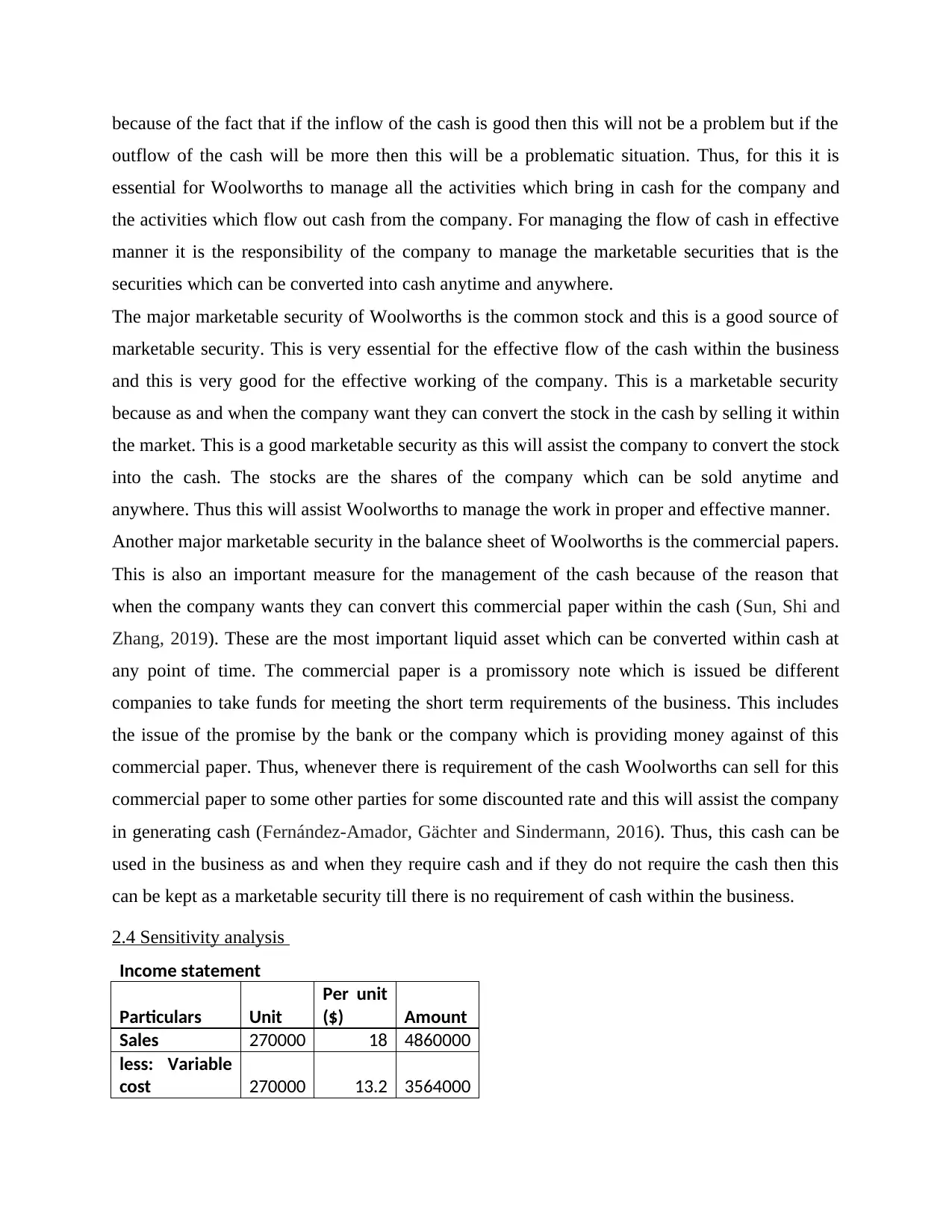
because of the fact that if the inflow of the cash is good then this will not be a problem but if the
outflow of the cash will be more then this will be a problematic situation. Thus, for this it is
essential for Woolworths to manage all the activities which bring in cash for the company and
the activities which flow out cash from the company. For managing the flow of cash in effective
manner it is the responsibility of the company to manage the marketable securities that is the
securities which can be converted into cash anytime and anywhere.
The major marketable security of Woolworths is the common stock and this is a good source of
marketable security. This is very essential for the effective flow of the cash within the business
and this is very good for the effective working of the company. This is a marketable security
because as and when the company want they can convert the stock in the cash by selling it within
the market. This is a good marketable security as this will assist the company to convert the stock
into the cash. The stocks are the shares of the company which can be sold anytime and
anywhere. Thus this will assist Woolworths to manage the work in proper and effective manner.
Another major marketable security in the balance sheet of Woolworths is the commercial papers.
This is also an important measure for the management of the cash because of the reason that
when the company wants they can convert this commercial paper within the cash (Sun, Shi and
Zhang, 2019). These are the most important liquid asset which can be converted within cash at
any point of time. The commercial paper is a promissory note which is issued be different
companies to take funds for meeting the short term requirements of the business. This includes
the issue of the promise by the bank or the company which is providing money against of this
commercial paper. Thus, whenever there is requirement of the cash Woolworths can sell for this
commercial paper to some other parties for some discounted rate and this will assist the company
in generating cash (Fernández-Amador, Gächter and Sindermann, 2016). Thus, this cash can be
used in the business as and when they require cash and if they do not require the cash then this
can be kept as a marketable security till there is no requirement of cash within the business.
2.4 Sensitivity analysis
Income statement
Particulars Unit
Per unit
($) Amount
Sales 270000 18 4860000
less: Variable
cost 270000 13.2 3564000
outflow of the cash will be more then this will be a problematic situation. Thus, for this it is
essential for Woolworths to manage all the activities which bring in cash for the company and
the activities which flow out cash from the company. For managing the flow of cash in effective
manner it is the responsibility of the company to manage the marketable securities that is the
securities which can be converted into cash anytime and anywhere.
The major marketable security of Woolworths is the common stock and this is a good source of
marketable security. This is very essential for the effective flow of the cash within the business
and this is very good for the effective working of the company. This is a marketable security
because as and when the company want they can convert the stock in the cash by selling it within
the market. This is a good marketable security as this will assist the company to convert the stock
into the cash. The stocks are the shares of the company which can be sold anytime and
anywhere. Thus this will assist Woolworths to manage the work in proper and effective manner.
Another major marketable security in the balance sheet of Woolworths is the commercial papers.
This is also an important measure for the management of the cash because of the reason that
when the company wants they can convert this commercial paper within the cash (Sun, Shi and
Zhang, 2019). These are the most important liquid asset which can be converted within cash at
any point of time. The commercial paper is a promissory note which is issued be different
companies to take funds for meeting the short term requirements of the business. This includes
the issue of the promise by the bank or the company which is providing money against of this
commercial paper. Thus, whenever there is requirement of the cash Woolworths can sell for this
commercial paper to some other parties for some discounted rate and this will assist the company
in generating cash (Fernández-Amador, Gächter and Sindermann, 2016). Thus, this cash can be
used in the business as and when they require cash and if they do not require the cash then this
can be kept as a marketable security till there is no requirement of cash within the business.
2.4 Sensitivity analysis
Income statement
Particulars Unit
Per unit
($) Amount
Sales 270000 18 4860000
less: Variable
cost 270000 13.2 3564000
Paraphrase This Document
Need a fresh take? Get an instant paraphrase of this document with our AI Paraphraser
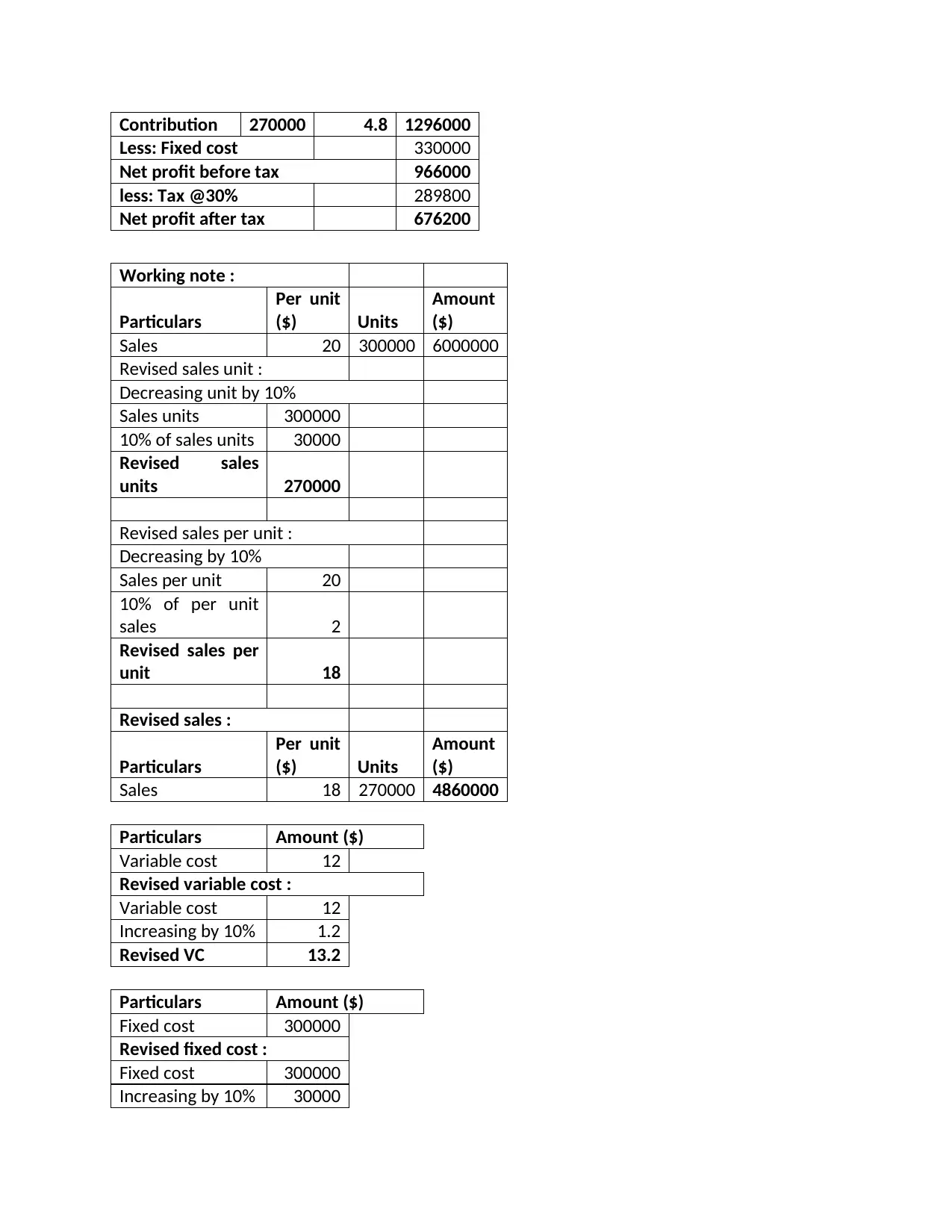
Contribution 270000 4.8 1296000
Less: Fixed cost 330000
Net profit before tax 966000
less: Tax @30% 289800
Net profit after tax 676200
Working note :
Particulars
Per unit
($) Units
Amount
($)
Sales 20 300000 6000000
Revised sales unit :
Decreasing unit by 10%
Sales units 300000
10% of sales units 30000
Revised sales
units 270000
Revised sales per unit :
Decreasing by 10%
Sales per unit 20
10% of per unit
sales 2
Revised sales per
unit 18
Revised sales :
Particulars
Per unit
($) Units
Amount
($)
Sales 18 270000 4860000
Particulars Amount ($)
Variable cost 12
Revised variable cost :
Variable cost 12
Increasing by 10% 1.2
Revised VC 13.2
Particulars Amount ($)
Fixed cost 300000
Revised fixed cost :
Fixed cost 300000
Increasing by 10% 30000
Less: Fixed cost 330000
Net profit before tax 966000
less: Tax @30% 289800
Net profit after tax 676200
Working note :
Particulars
Per unit
($) Units
Amount
($)
Sales 20 300000 6000000
Revised sales unit :
Decreasing unit by 10%
Sales units 300000
10% of sales units 30000
Revised sales
units 270000
Revised sales per unit :
Decreasing by 10%
Sales per unit 20
10% of per unit
sales 2
Revised sales per
unit 18
Revised sales :
Particulars
Per unit
($) Units
Amount
($)
Sales 18 270000 4860000
Particulars Amount ($)
Variable cost 12
Revised variable cost :
Variable cost 12
Increasing by 10% 1.2
Revised VC 13.2
Particulars Amount ($)
Fixed cost 300000
Revised fixed cost :
Fixed cost 300000
Increasing by 10% 30000
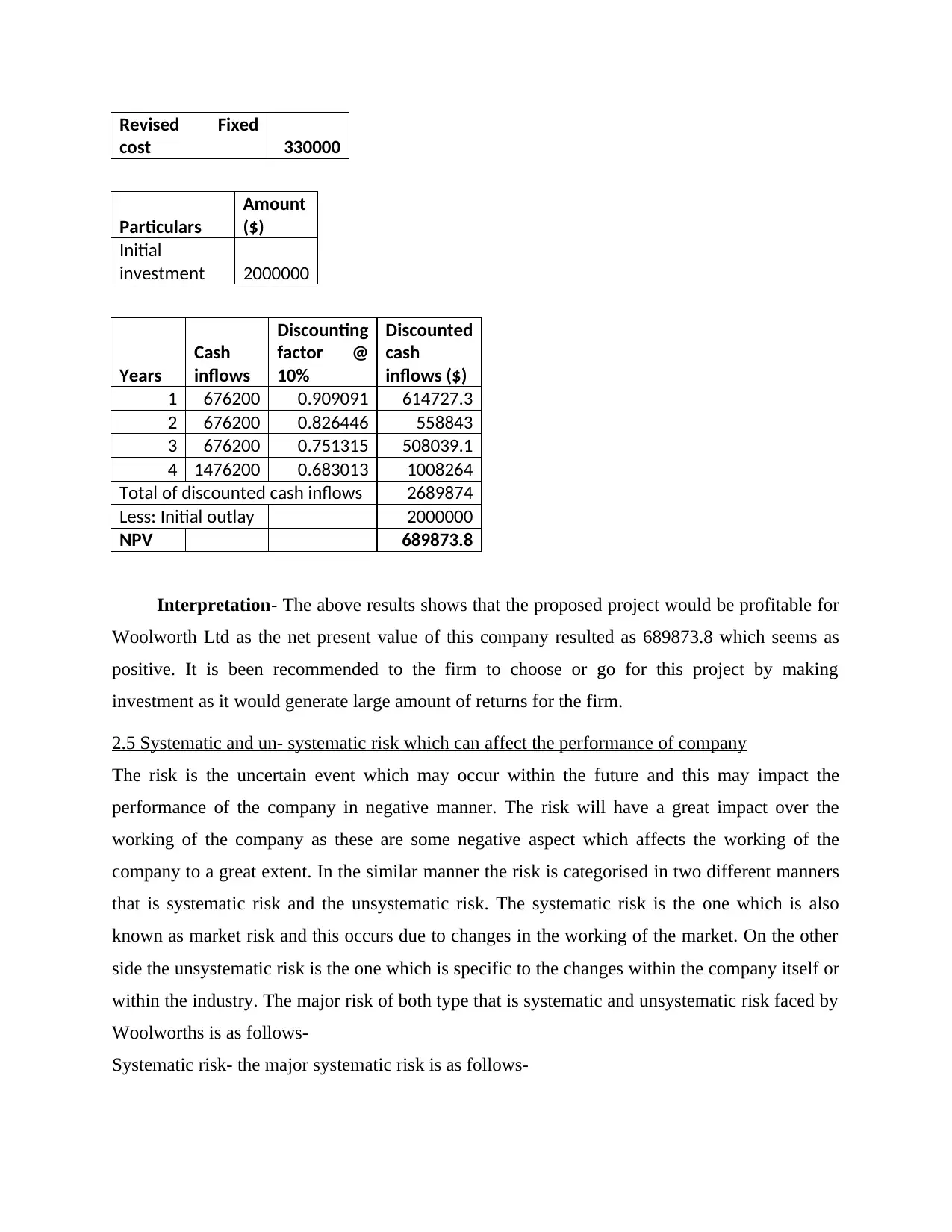
Revised Fixed
cost 330000
Particulars
Amount
($)
Initial
investment 2000000
Years
Cash
inflows
Discounting
factor @
10%
Discounted
cash
inflows ($)
1 676200 0.909091 614727.3
2 676200 0.826446 558843
3 676200 0.751315 508039.1
4 1476200 0.683013 1008264
Total of discounted cash inflows 2689874
Less: Initial outlay 2000000
NPV 689873.8
Interpretation- The above results shows that the proposed project would be profitable for
Woolworth Ltd as the net present value of this company resulted as 689873.8 which seems as
positive. It is been recommended to the firm to choose or go for this project by making
investment as it would generate large amount of returns for the firm.
2.5 Systematic and un- systematic risk which can affect the performance of company
The risk is the uncertain event which may occur within the future and this may impact the
performance of the company in negative manner. The risk will have a great impact over the
working of the company as these are some negative aspect which affects the working of the
company to a great extent. In the similar manner the risk is categorised in two different manners
that is systematic risk and the unsystematic risk. The systematic risk is the one which is also
known as market risk and this occurs due to changes in the working of the market. On the other
side the unsystematic risk is the one which is specific to the changes within the company itself or
within the industry. The major risk of both type that is systematic and unsystematic risk faced by
Woolworths is as follows-
Systematic risk- the major systematic risk is as follows-
cost 330000
Particulars
Amount
($)
Initial
investment 2000000
Years
Cash
inflows
Discounting
factor @
10%
Discounted
cash
inflows ($)
1 676200 0.909091 614727.3
2 676200 0.826446 558843
3 676200 0.751315 508039.1
4 1476200 0.683013 1008264
Total of discounted cash inflows 2689874
Less: Initial outlay 2000000
NPV 689873.8
Interpretation- The above results shows that the proposed project would be profitable for
Woolworth Ltd as the net present value of this company resulted as 689873.8 which seems as
positive. It is been recommended to the firm to choose or go for this project by making
investment as it would generate large amount of returns for the firm.
2.5 Systematic and un- systematic risk which can affect the performance of company
The risk is the uncertain event which may occur within the future and this may impact the
performance of the company in negative manner. The risk will have a great impact over the
working of the company as these are some negative aspect which affects the working of the
company to a great extent. In the similar manner the risk is categorised in two different manners
that is systematic risk and the unsystematic risk. The systematic risk is the one which is also
known as market risk and this occurs due to changes in the working of the market. On the other
side the unsystematic risk is the one which is specific to the changes within the company itself or
within the industry. The major risk of both type that is systematic and unsystematic risk faced by
Woolworths is as follows-
Systematic risk- the major systematic risk is as follows-
⊘ This is a preview!⊘
Do you want full access?
Subscribe today to unlock all pages.

Trusted by 1+ million students worldwide
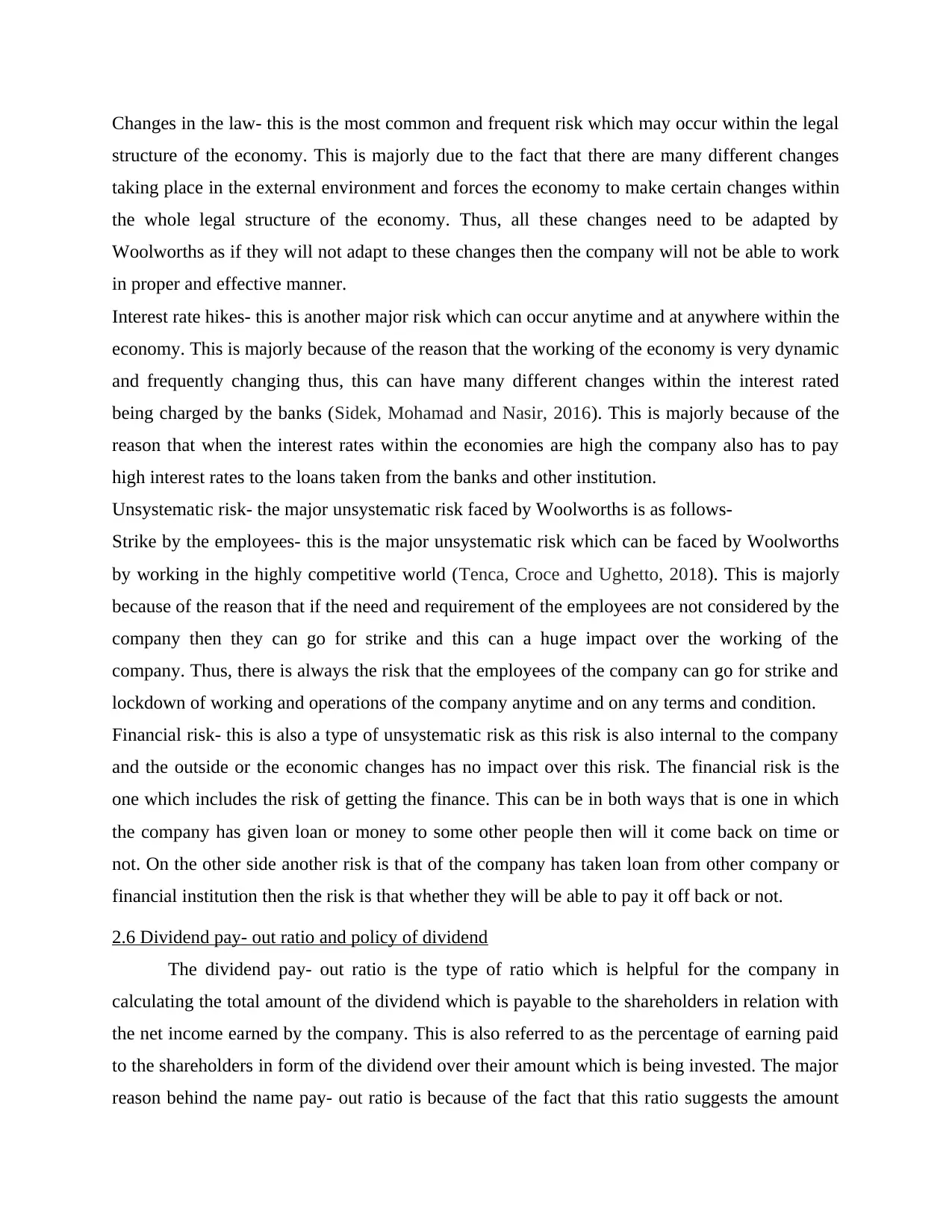
Changes in the law- this is the most common and frequent risk which may occur within the legal
structure of the economy. This is majorly due to the fact that there are many different changes
taking place in the external environment and forces the economy to make certain changes within
the whole legal structure of the economy. Thus, all these changes need to be adapted by
Woolworths as if they will not adapt to these changes then the company will not be able to work
in proper and effective manner.
Interest rate hikes- this is another major risk which can occur anytime and at anywhere within the
economy. This is majorly because of the reason that the working of the economy is very dynamic
and frequently changing thus, this can have many different changes within the interest rated
being charged by the banks (Sidek, Mohamad and Nasir, 2016). This is majorly because of the
reason that when the interest rates within the economies are high the company also has to pay
high interest rates to the loans taken from the banks and other institution.
Unsystematic risk- the major unsystematic risk faced by Woolworths is as follows-
Strike by the employees- this is the major unsystematic risk which can be faced by Woolworths
by working in the highly competitive world (Tenca, Croce and Ughetto, 2018). This is majorly
because of the reason that if the need and requirement of the employees are not considered by the
company then they can go for strike and this can a huge impact over the working of the
company. Thus, there is always the risk that the employees of the company can go for strike and
lockdown of working and operations of the company anytime and on any terms and condition.
Financial risk- this is also a type of unsystematic risk as this risk is also internal to the company
and the outside or the economic changes has no impact over this risk. The financial risk is the
one which includes the risk of getting the finance. This can be in both ways that is one in which
the company has given loan or money to some other people then will it come back on time or
not. On the other side another risk is that of the company has taken loan from other company or
financial institution then the risk is that whether they will be able to pay it off back or not.
2.6 Dividend pay- out ratio and policy of dividend
The dividend pay- out ratio is the type of ratio which is helpful for the company in
calculating the total amount of the dividend which is payable to the shareholders in relation with
the net income earned by the company. This is also referred to as the percentage of earning paid
to the shareholders in form of the dividend over their amount which is being invested. The major
reason behind the name pay- out ratio is because of the fact that this ratio suggests the amount
structure of the economy. This is majorly due to the fact that there are many different changes
taking place in the external environment and forces the economy to make certain changes within
the whole legal structure of the economy. Thus, all these changes need to be adapted by
Woolworths as if they will not adapt to these changes then the company will not be able to work
in proper and effective manner.
Interest rate hikes- this is another major risk which can occur anytime and at anywhere within the
economy. This is majorly because of the reason that the working of the economy is very dynamic
and frequently changing thus, this can have many different changes within the interest rated
being charged by the banks (Sidek, Mohamad and Nasir, 2016). This is majorly because of the
reason that when the interest rates within the economies are high the company also has to pay
high interest rates to the loans taken from the banks and other institution.
Unsystematic risk- the major unsystematic risk faced by Woolworths is as follows-
Strike by the employees- this is the major unsystematic risk which can be faced by Woolworths
by working in the highly competitive world (Tenca, Croce and Ughetto, 2018). This is majorly
because of the reason that if the need and requirement of the employees are not considered by the
company then they can go for strike and this can a huge impact over the working of the
company. Thus, there is always the risk that the employees of the company can go for strike and
lockdown of working and operations of the company anytime and on any terms and condition.
Financial risk- this is also a type of unsystematic risk as this risk is also internal to the company
and the outside or the economic changes has no impact over this risk. The financial risk is the
one which includes the risk of getting the finance. This can be in both ways that is one in which
the company has given loan or money to some other people then will it come back on time or
not. On the other side another risk is that of the company has taken loan from other company or
financial institution then the risk is that whether they will be able to pay it off back or not.
2.6 Dividend pay- out ratio and policy of dividend
The dividend pay- out ratio is the type of ratio which is helpful for the company in
calculating the total amount of the dividend which is payable to the shareholders in relation with
the net income earned by the company. This is also referred to as the percentage of earning paid
to the shareholders in form of the dividend over their amount which is being invested. The major
reason behind the name pay- out ratio is because of the fact that this ratio suggests the amount
Paraphrase This Document
Need a fresh take? Get an instant paraphrase of this document with our AI Paraphraser
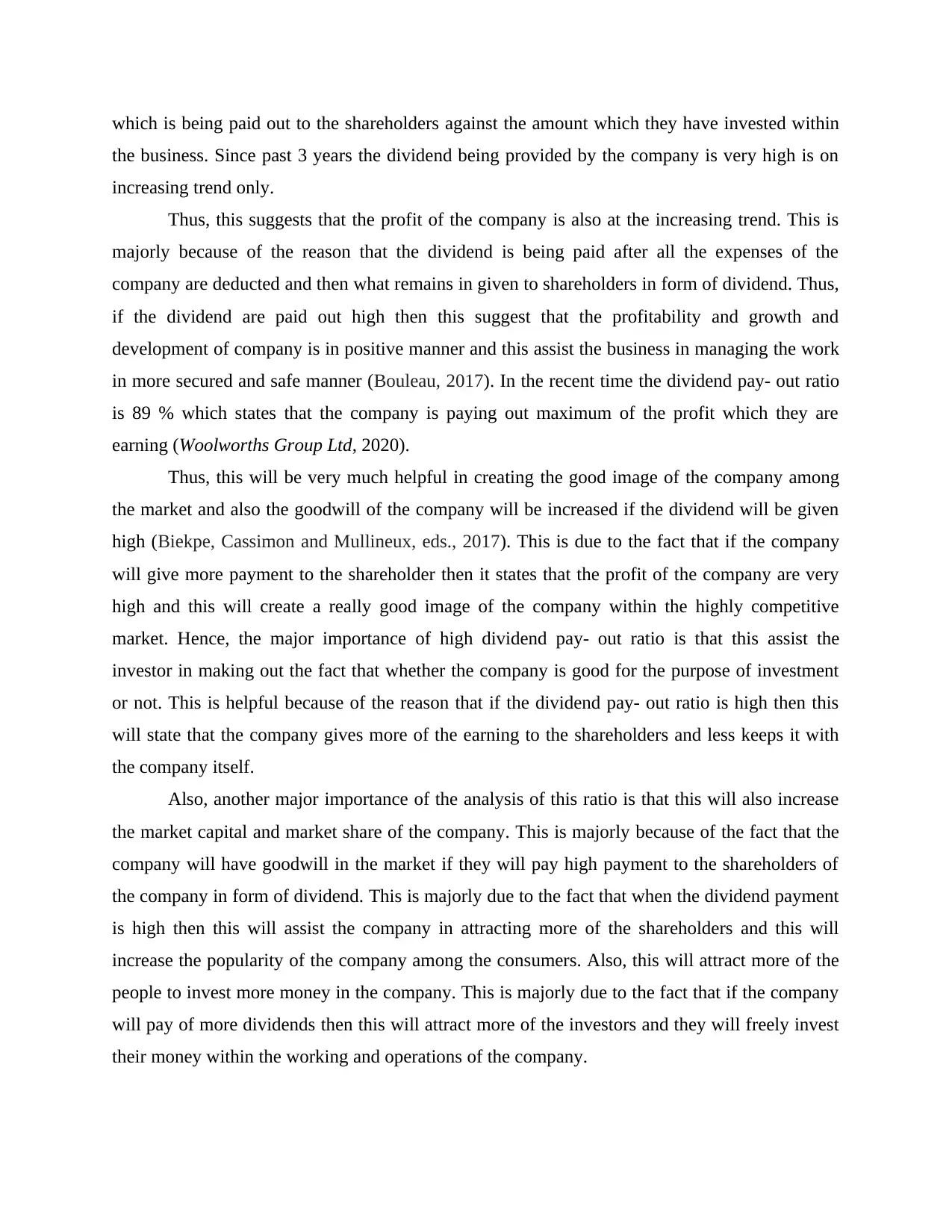
which is being paid out to the shareholders against the amount which they have invested within
the business. Since past 3 years the dividend being provided by the company is very high is on
increasing trend only.
Thus, this suggests that the profit of the company is also at the increasing trend. This is
majorly because of the reason that the dividend is being paid after all the expenses of the
company are deducted and then what remains in given to shareholders in form of dividend. Thus,
if the dividend are paid out high then this suggest that the profitability and growth and
development of company is in positive manner and this assist the business in managing the work
in more secured and safe manner (Bouleau, 2017). In the recent time the dividend pay- out ratio
is 89 % which states that the company is paying out maximum of the profit which they are
earning (Woolworths Group Ltd, 2020).
Thus, this will be very much helpful in creating the good image of the company among
the market and also the goodwill of the company will be increased if the dividend will be given
high (Biekpe, Cassimon and Mullineux, eds., 2017). This is due to the fact that if the company
will give more payment to the shareholder then it states that the profit of the company are very
high and this will create a really good image of the company within the highly competitive
market. Hence, the major importance of high dividend pay- out ratio is that this assist the
investor in making out the fact that whether the company is good for the purpose of investment
or not. This is helpful because of the reason that if the dividend pay- out ratio is high then this
will state that the company gives more of the earning to the shareholders and less keeps it with
the company itself.
Also, another major importance of the analysis of this ratio is that this will also increase
the market capital and market share of the company. This is majorly because of the fact that the
company will have goodwill in the market if they will pay high payment to the shareholders of
the company in form of dividend. This is majorly due to the fact that when the dividend payment
is high then this will assist the company in attracting more of the shareholders and this will
increase the popularity of the company among the consumers. Also, this will attract more of the
people to invest more money in the company. This is majorly due to the fact that if the company
will pay of more dividends then this will attract more of the investors and they will freely invest
their money within the working and operations of the company.
the business. Since past 3 years the dividend being provided by the company is very high is on
increasing trend only.
Thus, this suggests that the profit of the company is also at the increasing trend. This is
majorly because of the reason that the dividend is being paid after all the expenses of the
company are deducted and then what remains in given to shareholders in form of dividend. Thus,
if the dividend are paid out high then this suggest that the profitability and growth and
development of company is in positive manner and this assist the business in managing the work
in more secured and safe manner (Bouleau, 2017). In the recent time the dividend pay- out ratio
is 89 % which states that the company is paying out maximum of the profit which they are
earning (Woolworths Group Ltd, 2020).
Thus, this will be very much helpful in creating the good image of the company among
the market and also the goodwill of the company will be increased if the dividend will be given
high (Biekpe, Cassimon and Mullineux, eds., 2017). This is due to the fact that if the company
will give more payment to the shareholder then it states that the profit of the company are very
high and this will create a really good image of the company within the highly competitive
market. Hence, the major importance of high dividend pay- out ratio is that this assist the
investor in making out the fact that whether the company is good for the purpose of investment
or not. This is helpful because of the reason that if the dividend pay- out ratio is high then this
will state that the company gives more of the earning to the shareholders and less keeps it with
the company itself.
Also, another major importance of the analysis of this ratio is that this will also increase
the market capital and market share of the company. This is majorly because of the fact that the
company will have goodwill in the market if they will pay high payment to the shareholders of
the company in form of dividend. This is majorly due to the fact that when the dividend payment
is high then this will assist the company in attracting more of the shareholders and this will
increase the popularity of the company among the consumers. Also, this will attract more of the
people to invest more money in the company. This is majorly due to the fact that if the company
will pay of more dividends then this will attract more of the investors and they will freely invest
their money within the working and operations of the company.
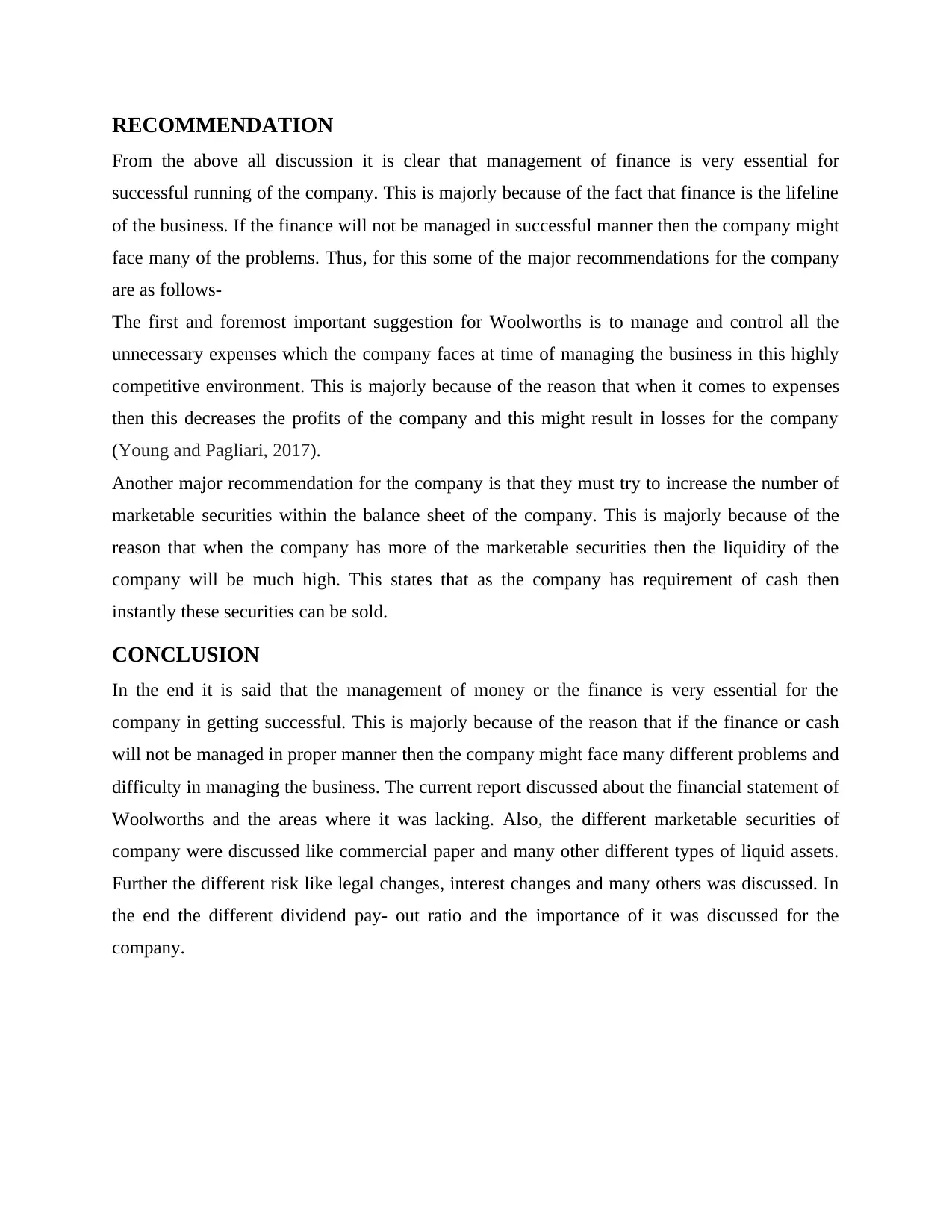
RECOMMENDATION
From the above all discussion it is clear that management of finance is very essential for
successful running of the company. This is majorly because of the fact that finance is the lifeline
of the business. If the finance will not be managed in successful manner then the company might
face many of the problems. Thus, for this some of the major recommendations for the company
are as follows-
The first and foremost important suggestion for Woolworths is to manage and control all the
unnecessary expenses which the company faces at time of managing the business in this highly
competitive environment. This is majorly because of the reason that when it comes to expenses
then this decreases the profits of the company and this might result in losses for the company
(Young and Pagliari, 2017).
Another major recommendation for the company is that they must try to increase the number of
marketable securities within the balance sheet of the company. This is majorly because of the
reason that when the company has more of the marketable securities then the liquidity of the
company will be much high. This states that as the company has requirement of cash then
instantly these securities can be sold.
CONCLUSION
In the end it is said that the management of money or the finance is very essential for the
company in getting successful. This is majorly because of the reason that if the finance or cash
will not be managed in proper manner then the company might face many different problems and
difficulty in managing the business. The current report discussed about the financial statement of
Woolworths and the areas where it was lacking. Also, the different marketable securities of
company were discussed like commercial paper and many other different types of liquid assets.
Further the different risk like legal changes, interest changes and many others was discussed. In
the end the different dividend pay- out ratio and the importance of it was discussed for the
company.
From the above all discussion it is clear that management of finance is very essential for
successful running of the company. This is majorly because of the fact that finance is the lifeline
of the business. If the finance will not be managed in successful manner then the company might
face many of the problems. Thus, for this some of the major recommendations for the company
are as follows-
The first and foremost important suggestion for Woolworths is to manage and control all the
unnecessary expenses which the company faces at time of managing the business in this highly
competitive environment. This is majorly because of the reason that when it comes to expenses
then this decreases the profits of the company and this might result in losses for the company
(Young and Pagliari, 2017).
Another major recommendation for the company is that they must try to increase the number of
marketable securities within the balance sheet of the company. This is majorly because of the
reason that when the company has more of the marketable securities then the liquidity of the
company will be much high. This states that as the company has requirement of cash then
instantly these securities can be sold.
CONCLUSION
In the end it is said that the management of money or the finance is very essential for the
company in getting successful. This is majorly because of the reason that if the finance or cash
will not be managed in proper manner then the company might face many different problems and
difficulty in managing the business. The current report discussed about the financial statement of
Woolworths and the areas where it was lacking. Also, the different marketable securities of
company were discussed like commercial paper and many other different types of liquid assets.
Further the different risk like legal changes, interest changes and many others was discussed. In
the end the different dividend pay- out ratio and the importance of it was discussed for the
company.
⊘ This is a preview!⊘
Do you want full access?
Subscribe today to unlock all pages.

Trusted by 1+ million students worldwide
1 out of 13
Related Documents
Your All-in-One AI-Powered Toolkit for Academic Success.
+13062052269
info@desklib.com
Available 24*7 on WhatsApp / Email
![[object Object]](/_next/static/media/star-bottom.7253800d.svg)
Unlock your academic potential
Copyright © 2020–2025 A2Z Services. All Rights Reserved. Developed and managed by ZUCOL.





